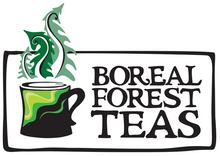How to Make a Great Cup of Tea
Great tea depends, first and foremost, on quality ingredients, and the conditions in which they are grown, harvested, processed and handled.
Everyone makes tea differently, and there is no shortage of information online that will guide your experimentation. Here are some basic guideline to help you get started so you can optimize the flavour of your tea, as well as your tea drinking experience.
1) Quantity
A general rule is 1 tsp of dried herbs per cup of water, but this will vary depending on the type of tea and your flavour preferences. Start with 1 tsp/cup and then experiment to find the right flavour and strength for you.
If you're making a pot, use one teaspoon of dried herbs for each cup of water plus "one for the teapot" (it's just an old tradition to show respect for your teaware).
2) Temperature
I could write a full article about this...
The 'correct' temperature will vary depending on the type of tea you are steeping. If the water is too hot, you risk scorching the leaves (they don’t like that). If the water is too cold, the herbs won't infuse properly and your tea will be 'weak'. Use these temperatures as a general rule:
- Herbal: 95°C
- Black: 95°C
- Green: 85°C
- White: 90°C
Having said that, in all the years I have made tea (many, many years!), I have rarely checked the water temperature. I either turn the kettle off just before it boils or let the water cool for a moment (a bit longer for green and white teas) if the water has already boiled. I’ve enjoyed countless fabulous cups of tea!
3) Steeping
Steeping times will again vary depending on the type of tea being steeped and how strong you like your tea. Again, it is important to experiment. I will get into the difference between infusions and decoctions (and which one to use for different plant parts), but for now let's say we are making an infusion. Use this as a general rule:
- Herbal: 5+ minutes
- Black: 3-5 minutes
- Green: 2-4 minutes
- White: 3-5 minutes
I enjoy my herbal tea stronger, so tend to steep it a bit longer.
I do not enjoy bitter green tea (who does!?), so I steep for two minutes or less.
4) Teaware
There is no end to the teaware, equipment and accessories you can purchase to brew and consume your tea. An infuser is the most common and comes in many shapes and sizes. Tea balls are inexpensive, but not my favourite, as they keep the tea leaves confined and they can't 'stretch out' in the water. I typically use a stainless-steel infuser that sits inside my cup or a French press.
You can also use NO teaware. Yes, that's right, you can keep it very simple by placing the dried leaves in a cup and adding your hot water. Most of the leaves will sink to the bottom once they've steeped long enough. I've used this method countless times (mostly when I've forgotten my infuser, or when I am camping). I respect that it is not everyone's preferred method, but I love it! Floating plants don't bother me (you can eat them!!), but if they bother you, use an infuser or a bombilla (stainless steel straw with a filter at the base).
How to Store Your Tea
To get the most out of your teas, proper storage is critical. Like all plants, teas are prone to picking up moisture from their environment. Plants also react to light and, over time, lose their vitality, colour and flavour. Follow these steps to keep your teas fresh and delicious:
- Keep it dry. Store your tea in an airtight container away from moisture. You do not want moldy tea! Never store in the refrigerator or freezer.
- Protect it from light, heat and air. When exposed to these elements, teas will lose their colour, flavour and potential health benefits. Store your tea in a cool place in opaque containers, or keep them in a cool, dry cupboard (not above the stove or next to the sink)
Again, there is no shortage of information online about tea brewing, so please experiment! That’s the best way to learn!
Happy sipping!
Lee-Ann



